
Bidens frondosa is a North American species of flowering plant in the aster family, Asteraceae. It is widespread across much of Canada, the United States, and Mexico It is known in many other parts of the world as an introduced species, including Europe, Asia, Morocco, and New Zealand. Its many common names include devil's beggarticks, devil's-pitchfork, devil's bootjack, sticktights, bur marigold, pitchfork weed, tickseed sunflower, leafy beggarticks, and common beggar-ticks.

Heterotheca is a genus of North American plants in the family Asteraceae.

Senecio viscosus is a herbaceous annual plant of the genus Senecio. It is known as the sticky ragwort, sticky groundsel, or stinking groundsel.

Hieracium lachenalii, also known as common hawkweed or yellow hawkweed, is a species of plant in the tribe Cichorieae within the family Asteraceae. It is native to Europe but has become established as a weed in Australia and parts of North America.

Bidens laevis is a species of flowering plant in the daisy family known by the common names larger bur-marigold and smooth beggarticks. It is native to South America, Mexico, and the southern and eastern United States. It grows in wetlands, including estuaries and riverbanks.

Chrysoma is a genus of flowering plants in the family Asteraceae.

Eucephalus is a genus of North American flowering plants in the family Asteraceae.
Engelmannia pinnatifida is a North American species of flowering plants in the family Asteraceae. It is native to the southern United States and northern Mexico, the States of Chihuahua, Coahuila, Nuevo León, Tamaulipas, Texas, New Mexico.

Bidens aristosa, known by many common names such as bearded beggarticks, western tickseed, showy tickseed, long-bracted beggarticks, tickseed beggarticks, swamp marigold, and Yankee lice, is an herbaceous, annual plant in the Asteraceae family. It is native to the central United States, but has been introduced to the eastern United States, Canada, France, Great Britain, and India. It grows in marshes, meadows, pine forests and disturbed sites.

Bidens alba, which belongs to the family Asteraceae, is most commonly known as shepherd's needles, beggarticks, Spanish needles, or butterfly needles. Bidens means two- toothed, describing the two projections found at the top of the seeds, and alba refers to the white ray florets. This plant is found in tropical and subtropical regions of North America, Asia, South America, and Africa, situated in gardens, road sides, farm fields and disturbed sites. B. alba is an annual or short-lived perennial, which is considered a weed in the United States. However, B. alba leaves are edible and can be used as medicinal remedies.

Berlandiera subacaulis is a North American species of flowering plant in the family Asteraceae. It is found only in Florida. The common name is Florida greeneyes.
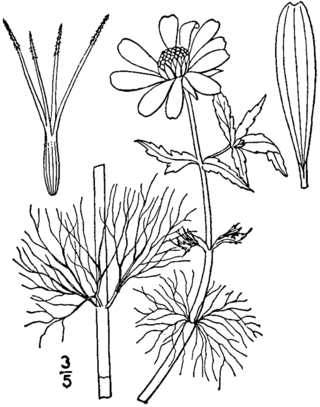
Bidens beckii, commonly called Beck's water-marigold or simply water marigold is a species of flowering plant in the family Asteraceae. It is native to Canada and the northern United States.
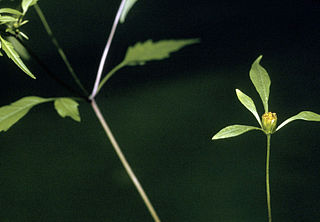
Bidens discoidea, commonly known as small beggarticks, is an annual, herbaceous, flowering plant in the Asteraceae family. It is widespread across eastern Canada and the eastern and central United States, from Nova Scotia west to Minnesota, south to Florida and Texas.

Bidens eatonii is a North American species of flowering plant in the family Asteraceae. It is native to eastern Canada and the northeastern United States.

Bidens hyperborea is a variable species of flowering plant in the family Asteraceae, known from estuarine regions in northeastern North America. It is similar to Bidens cernua, Bidens laevis, and Bidens eatonii. B. hyperborea is listed as an endangered species in the state of Massachusetts, where it is threatened by habitat degradation, and is listed by NatureServe as critically imperiled (S1) in the province of Ontario and possibly extirpated from New Hampshire.
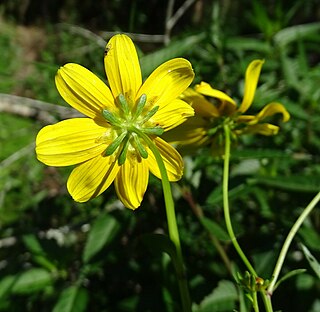
Bidens mitis, the smallfruit beggarticks, is a North American species of flowering plant in the family Asteraceae. It is native to the eastern, southeastern, and south-central parts of the United States, from eastern Texas to southern New Jersey.
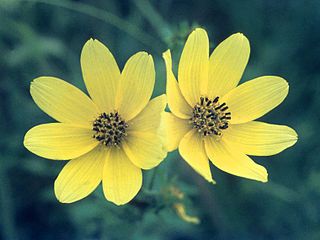
Bidens trichosperma, the marsh beggar-ticks or marsh tickseed, is a North American species of flowering plant in the family Asteraceae. It is native to central Canada and to the eastern and north-central United States.

Erigeron filifolius is a North American species of flowering plants in the family Asteraceae known by the common names thread-leaf fleabane.

Erigeron subtrinervis, called the three-nerved daisy, the three-nerve fleabane, or the hairy showy daisy, is a North American species of flowering plants in the family Asteraceae. It grows in various mountains of western Canada and the western United States: Rocky Mountains, northern Cascades, Black Hills, etc., from British Columbia and Washington state east to North Dakota and south as far as New Mexico.
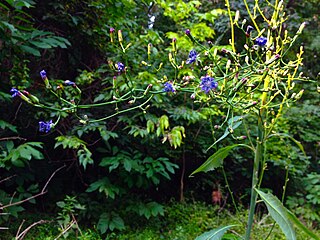
Lactuca floridana, commonly known as woodland lettuce, Florida lettuce, or false lettuce is a North American species of wild lettuce. It is native across much of central Canada and the eastern and central United States.




















